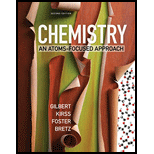
Chemistry: An Atoms-Focused Approach (Second Edition)
2nd Edition
ISBN: 9780393614053
Author: Thomas R. Gilbert, Rein V. Kirss, Stacey Lowery Bretz, Natalie Foster
Publisher: W. W. Norton & Company
expand_more
expand_more
format_list_bulleted
Question
Chapter 6, Problem 6.7VP
Interpretation Introduction
To find:
If the sample of X is left outside in a sealed container on a summer day, will the X in the container be
Expert Solution & Answer
Want to see the full answer?
Check out a sample textbook solution
Students have asked these similar questions
If the normal potential for the Fe(III)/Fe(II) pair in acid at zero pH is 524 mV Hg/Hg2Cl2 . The potential of the saturated calomel reference electrode is +246 mV versus the NHE. Calculate E0 vs NHE.
Given the galvanic cell whose scheme is: (-) Zn/Zn2+ ⋮⋮ Ag+/Ag (+). If we know the normal potentials E°(Zn2+/Zn) = -0.76V and E°(Ag+/Ag) = 0.799 V. Indicate the electrodes that are the anode and the cathode and calculate the E0battery.
Indicate the functions that salt bridges have in batteries.
Chapter 6 Solutions
Chemistry: An Atoms-Focused Approach (Second Edition)
Ch. 6 - Prob. 6.1VPCh. 6 - Prob. 6.2VPCh. 6 - Prob. 6.3VPCh. 6 - Prob. 6.4VPCh. 6 - Prob. 6.5VPCh. 6 - Prob. 6.6VPCh. 6 - Prob. 6.7VPCh. 6 - Prob. 6.8VPCh. 6 - Prob. 6.9VPCh. 6 - Prob. 6.10VP
Ch. 6 - Prob. 6.11VPCh. 6 - Prob. 6.12VPCh. 6 - Prob. 6.13VPCh. 6 - Prob. 6.14VPCh. 6 - Prob. 6.15VPCh. 6 - Prob. 6.16VPCh. 6 - Prob. 6.17QACh. 6 - Prob. 6.18QACh. 6 - Prob. 6.19QACh. 6 - Prob. 6.20QACh. 6 - Prob. 6.21QACh. 6 - Prob. 6.22QACh. 6 - Prob. 6.23QACh. 6 - Prob. 6.24QACh. 6 - Prob. 6.25QACh. 6 - Prob. 6.26QACh. 6 - Prob. 6.27QACh. 6 - Prob. 6.28QACh. 6 - Prob. 6.29QACh. 6 - Prob. 6.30QACh. 6 - Prob. 6.31QACh. 6 - Prob. 6.32QACh. 6 - Prob. 6.33QACh. 6 - Prob. 6.34QACh. 6 - Prob. 6.35QACh. 6 - Prob. 6.36QACh. 6 - Prob. 6.37QACh. 6 - Prob. 6.38QACh. 6 - Prob. 6.39QACh. 6 - Prob. 6.40QACh. 6 - Prob. 6.41QACh. 6 - Prob. 6.42QACh. 6 - Prob. 6.43QACh. 6 - Prob. 6.44QACh. 6 - Prob. 6.45QACh. 6 - Prob. 6.46QACh. 6 - Prob. 6.47QACh. 6 - Prob. 6.48QACh. 6 - Prob. 6.49QACh. 6 - Prob. 6.50QACh. 6 - Prob. 6.51QACh. 6 - Prob. 6.52QACh. 6 - Prob. 6.53QACh. 6 - Prob. 6.54QACh. 6 - Prob. 6.55QACh. 6 - Prob. 6.56QACh. 6 - Prob. 6.57QACh. 6 - Prob. 6.58QACh. 6 - Prob. 6.59QACh. 6 - Prob. 6.60QACh. 6 - Prob. 6.61QACh. 6 - Prob. 6.62QACh. 6 - Prob. 6.63QACh. 6 - Prob. 6.64QACh. 6 - Prob. 6.65QACh. 6 - Prob. 6.66QACh. 6 - Prob. 6.67QACh. 6 - Prob. 6.68QACh. 6 - Prob. 6.69QACh. 6 - Prob. 6.70QACh. 6 - Prob. 6.71QACh. 6 - Prob. 6.72QACh. 6 - Prob. 6.73QACh. 6 - Prob. 6.74QACh. 6 - Prob. 6.75QACh. 6 - Prob. 6.76QACh. 6 - Prob. 6.77QACh. 6 - Prob. 6.78QACh. 6 - Prob. 6.79QACh. 6 - Prob. 6.80QACh. 6 - Prob. 6.81QACh. 6 - Prob. 6.82QACh. 6 - Prob. 6.83QACh. 6 - Prob. 6.84QACh. 6 - Prob. 6.85QACh. 6 - Prob. 6.86QACh. 6 - Prob. 6.87QACh. 6 - Prob. 6.88QACh. 6 - Prob. 6.89QACh. 6 - Prob. 6.90QACh. 6 - Prob. 6.91QACh. 6 - Prob. 6.92QACh. 6 - Prob. 6.93QACh. 6 - Prob. 6.94QACh. 6 - Prob. 6.95QACh. 6 - Prob. 6.96QACh. 6 - Prob. 6.97QACh. 6 - Prob. 6.98QACh. 6 - Prob. 6.99QACh. 6 - Prob. 6.100QA
Knowledge Booster
Similar questions
- In the battery:Pt | H2 (g) | H+ (aq) | Fe2+ (aq) | FeIndicate the cathode and anode.arrow_forwardWrite the equations that occur when the electrode Pb (s) | PbI2 (s) | KI (ac) in a galvanic cell. a) It functions as a positive electrode b) It functions as a negative electrode c) What is the ion with respect to which this electrode is reversible?arrow_forwardState the formula to find the electromotive force of a battery as a function of the potential of the anode and the cathode.arrow_forward
- Why are normal electrode potentials also called relative electrode potentials?arrow_forwardEasily differentiate between electrochemical potential and Galvani potential.arrow_forwardConstruct a molecular orbital diagram for carbon monoxide. Identify the relevant point group,include all of the appropriate symmetry labels and pictures, and fill in the electrons. Make sure toaccount for the difference in electronegativity between C and O. Hint: CO is substantiallyisoelectronic to N2. (PLEASE DRAW THE ENTIRE MO DIAGRAM!!!)arrow_forward
arrow_back_ios
SEE MORE QUESTIONS
arrow_forward_ios
Recommended textbooks for you
 ChemistryChemistryISBN:9781305957404Author:Steven S. Zumdahl, Susan A. Zumdahl, Donald J. DeCostePublisher:Cengage Learning
ChemistryChemistryISBN:9781305957404Author:Steven S. Zumdahl, Susan A. Zumdahl, Donald J. DeCostePublisher:Cengage Learning ChemistryChemistryISBN:9781259911156Author:Raymond Chang Dr., Jason Overby ProfessorPublisher:McGraw-Hill Education
ChemistryChemistryISBN:9781259911156Author:Raymond Chang Dr., Jason Overby ProfessorPublisher:McGraw-Hill Education Principles of Instrumental AnalysisChemistryISBN:9781305577213Author:Douglas A. Skoog, F. James Holler, Stanley R. CrouchPublisher:Cengage Learning
Principles of Instrumental AnalysisChemistryISBN:9781305577213Author:Douglas A. Skoog, F. James Holler, Stanley R. CrouchPublisher:Cengage Learning Organic ChemistryChemistryISBN:9780078021558Author:Janice Gorzynski Smith Dr.Publisher:McGraw-Hill Education
Organic ChemistryChemistryISBN:9780078021558Author:Janice Gorzynski Smith Dr.Publisher:McGraw-Hill Education Chemistry: Principles and ReactionsChemistryISBN:9781305079373Author:William L. Masterton, Cecile N. HurleyPublisher:Cengage Learning
Chemistry: Principles and ReactionsChemistryISBN:9781305079373Author:William L. Masterton, Cecile N. HurleyPublisher:Cengage Learning Elementary Principles of Chemical Processes, Bind...ChemistryISBN:9781118431221Author:Richard M. Felder, Ronald W. Rousseau, Lisa G. BullardPublisher:WILEY
Elementary Principles of Chemical Processes, Bind...ChemistryISBN:9781118431221Author:Richard M. Felder, Ronald W. Rousseau, Lisa G. BullardPublisher:WILEY

Chemistry
Chemistry
ISBN:9781305957404
Author:Steven S. Zumdahl, Susan A. Zumdahl, Donald J. DeCoste
Publisher:Cengage Learning

Chemistry
Chemistry
ISBN:9781259911156
Author:Raymond Chang Dr., Jason Overby Professor
Publisher:McGraw-Hill Education

Principles of Instrumental Analysis
Chemistry
ISBN:9781305577213
Author:Douglas A. Skoog, F. James Holler, Stanley R. Crouch
Publisher:Cengage Learning

Organic Chemistry
Chemistry
ISBN:9780078021558
Author:Janice Gorzynski Smith Dr.
Publisher:McGraw-Hill Education

Chemistry: Principles and Reactions
Chemistry
ISBN:9781305079373
Author:William L. Masterton, Cecile N. Hurley
Publisher:Cengage Learning

Elementary Principles of Chemical Processes, Bind...
Chemistry
ISBN:9781118431221
Author:Richard M. Felder, Ronald W. Rousseau, Lisa G. Bullard
Publisher:WILEY